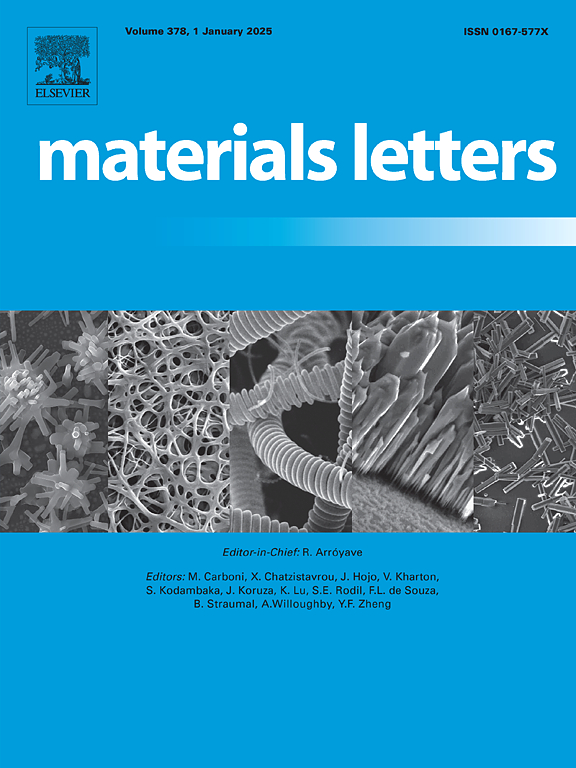制备负载有 Melastoma dodecandrum Lour.提取物的纳米纤维膜的制备
IF 2.7
4区 材料科学
Q3 MATERIALS SCIENCE, MULTIDISCIPLINARY
引用次数: 0
摘要
黄连是一种具有快速止血作用的植物,主要分布于中国贵州、广西、广东等省区。在这项研究中,我们利用十二皂角 Melastoma dodecandrum Lour.提取物(MDLE)制备了一种新型快速止血伤口敷料。采用电纺丝法制备了由聚乙烯醇(PVA)、壳聚糖(CS)和不同剂量的MDLE组成的纳米纤维膜(PVA/CS/MDLE)。然后,使用 SEM、FTIR 和 XRD 对每组纳米纤维膜进行了表征。PVA/CS、PVA/CS/2.8 %-MDLE、PVA/CS/5.5 %-MDLE和PVA/CS/8.2 %-MDLE的直径分别为207.2 ± 36.65 nm、313.3 ± 68.14 nm、350.0 ± 80.55 nm和371.1 ± 82.84 nm。PVA/CS/2.8 %-MDLE 的机械强度最大,而 PVA/CS/5.5 %-MDLE 的断裂伸长率最大。PVA/CS/5.5 %-MDLE 和 PVA/CS/8.2 %-MDLE 具有显著的抑菌作用,对金黄色葡萄球菌的抑制效果优于对大肠杆菌的抑制效果。PVA/CS/8.2 %-MDLE 组具有明显的止血效果(P < 0.001),所有组均表现出亲水性、膨胀比和低毒性。随着药物浓度的增加,止血所需时间缩短。总之,这些研究结果表明,PVA/CS/MDLE 作为伤口敷料具有很大的潜力。据我们所知,这是首次使用 MDLE 成功制备出具有快速止血功能的纳米纤维。本文章由计算机程序翻译,如有差异,请以英文原文为准。
Preparation of a nanofiber membrane loaded with Melastoma dodecandrum Lour. Extract for rapid hemostasis
Melastoma dodecandrum Lour. is a plant with a rapid hemostatic effect that is mainly distributed in Guizhou, Guangxi, Guangdong, and other provinces in China. In this study, we prepared a new rapid hemostatic wound dressing using Melastoma dodecandrum Lour. extract (MDLE). Nanofiber membranes (PVA/CS/MDLE) consisting of polyvinyl alcohol (PVA), chitosan (CS), and different doses of MDLE were prepared using an electrospinning method. Then, each group of nanofiber membranes was characterized using SEM, FTIR, and XRD. The diameters of PVA/CS, PVA/CS/2.8 %-MDLE, PVA/CS/5.5 %-MDLE, and PVA/CS/8.2 %-MDLE were 207.2 ± 36.65 nm, 313.3 ± 68.14 nm, 350.0 ± 80.55 nm, and 371.1 ± 82.84 nm, respectively. PVA/CS/2.8 %-MDLE exhibited the greatest mechanical strength, while PVA/CS/5.5 %-MDLE exhibited the greatest elongation at break. PVA/CS/5.5 %-MDLE and PVA/CS/8.2 %-MDLE exhibited significant bacteriostatic effects and inhibited Staphylococcus aureus more effectively than Escherichia coli. The PVA/CS/8.2 %-MDLE group had a significant hemostatic effect (P < 0.001), and all groups exhibited hydrophilicity, swelling ratios, and low toxicity. As the drug concentration increased, the time required for hemostasis decreased. Overall, these findings demonstrated that the PVA/CS/MDLE has great potential as a wound dressing. To our knowledge, this is the first time that a functional nanofiber with rapid hemostasis has been successfully prepared using MDLE.
求助全文
通过发布文献求助,成功后即可免费获取论文全文。
去求助
来源期刊

Materials Letters
工程技术-材料科学:综合
CiteScore
5.60
自引率
3.30%
发文量
1948
审稿时长
50 days
期刊介绍:
Materials Letters has an open access mirror journal Materials Letters: X, sharing the same aims and scope, editorial team, submission system and rigorous peer review.
Materials Letters is dedicated to publishing novel, cutting edge reports of broad interest to the materials community. The journal provides a forum for materials scientists and engineers, physicists, and chemists to rapidly communicate on the most important topics in the field of materials.
Contributions include, but are not limited to, a variety of topics such as:
• Materials - Metals and alloys, amorphous solids, ceramics, composites, polymers, semiconductors
• Applications - Structural, opto-electronic, magnetic, medical, MEMS, sensors, smart
• Characterization - Analytical, microscopy, scanning probes, nanoscopic, optical, electrical, magnetic, acoustic, spectroscopic, diffraction
• Novel Materials - Micro and nanostructures (nanowires, nanotubes, nanoparticles), nanocomposites, thin films, superlattices, quantum dots.
• Processing - Crystal growth, thin film processing, sol-gel processing, mechanical processing, assembly, nanocrystalline processing.
• Properties - Mechanical, magnetic, optical, electrical, ferroelectric, thermal, interfacial, transport, thermodynamic
• Synthesis - Quenching, solid state, solidification, solution synthesis, vapor deposition, high pressure, explosive
 求助内容:
求助内容: 应助结果提醒方式:
应助结果提醒方式:


